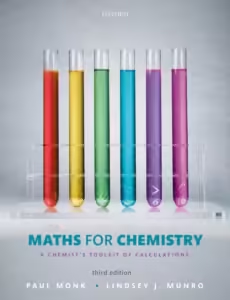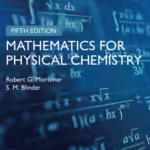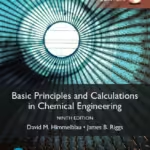 Free download Maths for Chemistry: A Chemist’s Toolkit of Calculations (3rd edition) authored by Paul Monk and Lindsey J. Munro in pdf.
Free download Maths for Chemistry: A Chemist’s Toolkit of Calculations (3rd edition) authored by Paul Monk and Lindsey J. Munro in pdf.
Maths for Chemistry by Paul Monk and Lindsey J. Munro is a highly practical and approachable guide designed specifically for chemistry students who need to develop strong mathematical skills. This third edition continues to build on the solid foundations of the previous versions, offering a comprehensive yet accessible resource that bridges the often daunting gap between mathematics and chemistry.
One of the standout features of the book is its tailored approach to teaching math in the context of chemistry. Instead of assuming prior advanced mathematical knowledge, the authors take a step-by-step approach, starting from basic concepts and gradually working up to more complex topics like calculus and logarithms. This progression ensures that students who may feel intimidated by math can follow along without feeling overwhelmed.
The book is rich in examples directly related to chemical problems, which helps to solidify the connection between theory and practical application. Each chapter introduces mathematical techniques and follows them up with real-world chemical calculations, making it easier for students to see the relevance of the math they’re learning. For instance, topics like exponential decay, rates of reaction, and chemical equilibria are explored mathematically, with clear explanations and well-chosen worked examples.
What makes this edition particularly useful is the inclusion of numerous practice problems and exercises. These problems range in difficulty, allowing students to build their confidence as they progress through the material. The step-by-step solutions provided in the book offer clarity and serve as a valuable tool for self-assessment.
Monk and Munro also address common misconceptions and difficulties that students might encounter when applying math to chemistry. Their approachable writing style, combined with the logical structure of the book, makes potentially difficult concepts like differential equations and probability seem more manageable.
The visual layout of the book is well thought-out, with clear diagrams, boxed explanations, and highlighted key formulas. This attention to design aids in comprehension, making the book a user-friendly resource for both self-study and guided learning. Additionally, the third edition updates and refines examples, ensuring that the content remains relevant to modern chemistry education.
One area where the book truly excels is in its focus on helping students not just memorize mathematical procedures, but understand why they are important. By consistently relating mathematical techniques to chemical principles, Maths for Chemistry helps students develop a deeper appreciation of how these two disciplines intertwine.
In conclusion, Maths for Chemistry (3rd Ed.) is an essential toolkit for any chemistry student looking to strengthen their mathematical skills. Whether you’re just beginning your studies or need a refresher, this book is a valuable companion that makes math both accessible and relevant to chemistry. It’s a thoughtful and well-crafted resource that fills a vital niche in the world of scientific education.
Contents
Section A: Core mathematics: algebra, logarithms, and trigonometry
- The display of numbers: Standard factors, algebraic phrases, scientific notation, significant figures, and decimal places
- Algebra I: Introducing notation, symbols, and operators
- Algebra II: The correct order to perform a series of operations: BODMAS
- Algebra III: Simplifying equations
- Algebra IV: Fractions and percentages
- Algebra V: Rearranging simple equations
- Algebra VI: Multiplying brackets and factorizing
- Algebra VII: Solving simultaneous linear equations
- Powers I: Introducing indices and powers
- Powers II: Exponentials and logarithms
- Trigonometry
- Advanced BODMAS: Rearranging equations with more complicated functions
Section B: Calculus
- Differentiation I: Rates of change, tangents, and differentiation
- Differentiation II: Differentiating other functions
- Differentiation III: Differentiating functions of functions: the chain rule
- Differentiation IV: The product rule and the quotient rule
- Differentiation V: Higher-order differentials and turning points
- Differentiation VI: Partial differentiation
- Integration I: Reversing the process of differentiation
- Integration II: Separating the variables and integrating with limits
- Integration III: Integration by parts, by substitution, with power series, and using published tables
- Integration IV: Integrating areas and volumes, and multiple integration
Section C: Matrices, vectors, and complex numbers
- Matrices I
- Matrices II: Symmetry operations and symmetry elements
- Complex numbers
- Vectors
Section D: Laboratory mathematics
- Graphs I: Pictorial representations of functions
- Graphs II: The equation of a straight-line graph
- Graphs III: Obtaining linear graphs from non-linear functions
- Probability I: Quantifying a likelihood
- Probability II: Partition functions and wavefunctions
- Statistics I: Averages and simple data analysis
- Statistics II: Treatment and assessment of errors
- Statistics III: Variance and significance testing
- Statistics IV: Analyses with multiple data sets and ANOVA
- Dimensional analysis
Free download Maths for Chemistry: A Chemist’s Toolkit of Calculations (3rd edition) authored by Paul Monk and Lindsey J. Munro in pdf from following download links.
Please follow these instructions to unlock the download link(s). If the download link(s) do not appear on mobile devices, try accessing this page from a laptop or desktop computer.
Password for Download Links: chemistry.com.pk
File Size: 6.79 MB. Pages: 825. Download Instructions. Kindly read the disclaimer.
You can also buy Maths for Chemistry: A Chemist’s Toolkit of Calculations (3rd edition) authored by Paul Monk and Lindsey J. Munro from Amazon by clicking the image below.



